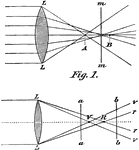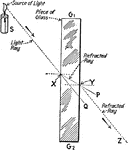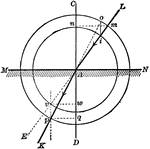Clipart tagged: ‘refraction’

Aberration
"In optics, a deviation in the rays of light when unequally refracted by a lens or reflected…

Cup and Shilling
"The refraction of water is beautifully proved by the following simple experiment. Place an empty cup,…

Refraction of Light through Bi Convex Lens
"...let LN represent a glass biconvex lens, with centres of curvature at C and C', and AB, the incident…

Convex Lens
"When the object is at a long distance from the lens, the image formed is smaller than the object, and…

Refraction
"The following simple experiment illustrates the effect of refraction:—Place a silver coin, m,…

Sound Refraction
"Fill with carbon dioxide a large rubber toy balloon or other double-convex lens having easily flexible…

Refraction of Light through Glass
"Illustrating refraction of light from a source through glass, and the appropriate angles of refraction."…

Refraction Between Mediums
"Since air is a rarer medium and water is denser, as ray A passes into the water, it is refracted to…

Refraction of Light
"Although a ray of light will pass in a straight line, when not interrupted, yet when it passes obliquely…

Refraction, air, water, glass
"Let a represent a, b water, and c a piece of glass. The ray d, striking each medium in a perpendicular…

Object Refracted through Biconvex Lens
"Showing how an object is refracted through a biconvex lens." -Avery 1895

Refraction by Plates
"When radiant energy passes through a medium bounded by parallel planes, the refractions at the two…

Refraction of Complimentary Colors
"The prism will deflect the red and orange, and form a reddish colored image at n. The violet, indigo,…

Explanation of Refraction
"Thus, when erher waves that constitute light are transmitted through glass, they are hindered by the…

Refraction, glass and water
"Let the medium b be glass, and the medium c, water. The ray a, as it falls upon the medium b, is refracted…

Refraction of Light Between Air and Water
"LA represents a ray of light propagated in air, falling obliquely upon the surface of the water at…

Refraction of Light Between Water and Air
"If the ray passes in the opposite direction, i.e., from water into air, the process is the reverse…

Refraction as seen by the Human Eye
"If the coin were to be observed in an empty pan and then watched as the pan was filled with water,…

Refraction, water
"Suppose the rod a, to be set with one half of its length below the surface of the water and the other…

Spectrometer
"An instrument used chiefly to measure the angular deviation of light rays in passing through a prism,…

Straight Prisms
"Condensing Straight Prisms.—These, either by reflexion or refraction or both, cause a ray fr…
